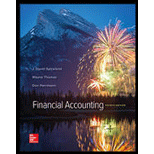
Concept explainers
(1)
Asset:
Assets refer to the resources owned by the business, which are utilized in the course of the business to generate revenue.
Liability:
Liabilities include the claims of the creditors on the assets of the business. The liability is the obligation of the business.
Stockholder’s equity:
Stockholder’s equity refers to the right the owner possesses over the resources of the business. Revenues and the expenses are the components of the owner’s equity.
Revenues:
Revenue refers to the income received from the business activity or sale of the output, during the accounting period.
Expenses:
Expenses refer to the cost incurred on the necessary purchases of the fixed assets by the firm, or the production of the goods and services, during the accounting period.
To Indicate: The type of account for each of the given accounts.
(2)
Normal balance:
Normal balance refers to the excess of amount on one side, over the amount on the other side in an account. The excess amount of debit side over the credit side is shown as the normal debit balance. The excess amount of credit side over the debit side is shown as the normal credit balance.
| Type of account | Normal balance |
| Asset account | Debit balance |
| Liability account | Credit balance |
| Expense account | Debit balance |
| Revenue account | Credit balance |
| Credit balance | |
| Dividend account | Debit balance |
Table (2)
To Indicate: The type of account for each of the given accounts.
Want to see the full answer?
Check out a sample textbook solution
Chapter 2 Solutions
FINANCIAL ACCOUNTINGLL W/CONNECT >IC<
- Last year, Orion Enterprises had the following results: ⚫ Sales = $800,000 Variable expenses = $480,000 Fixed expenses = $120,000 a. What is the degree of operating leverage at the current level of sales? b. If sales increase by 10% next year, by how much will net operating income increase (in dollars)?arrow_forwardWhat is the company's return on investment?arrow_forwardI need help with this problem and accounting questionarrow_forward
- Hi experts please provide answer this financial accounting questionarrow_forwardFinancial Accounting Questionarrow_forwardPrada Manufacturing had a Work in Process balance of $72,000 on January 1, 2022. The year-end balance of Work in Process was $95,000, and the Cost of Goods Manufactured was $730,000. Use this information to determine the total manufacturing costs incurred during the fiscal year 2022. Right answerarrow_forward
- Account subject probarrow_forwardBrightline Inc. uses direct labor hours to apply overhead. • Estimated DLH = 15,000 hours • Estimated overhead = $360,000 Actual DLH = 14,500 hours Actual overhead = $330,000 Determine whether overhead is overapplied or underapplied.arrow_forwardThe Ivam Department transferred 6,000 units to the finished goods storeroom for a month. There was no beginning work in process inventory, but 800 units were still in process at the end of the month and were 70% complete, and production costs incurred totaled $21,320. Inventory costs would be determined using a unit cost of $____.arrow_forward
- Principles of Accounting Volume 1AccountingISBN:9781947172685Author:OpenStaxPublisher:OpenStax College
 Financial Accounting: The Impact on Decision Make...AccountingISBN:9781305654174Author:Gary A. Porter, Curtis L. NortonPublisher:Cengage Learning
Financial Accounting: The Impact on Decision Make...AccountingISBN:9781305654174Author:Gary A. Porter, Curtis L. NortonPublisher:Cengage Learning  Intermediate Accounting: Reporting And AnalysisAccountingISBN:9781337788281Author:James M. Wahlen, Jefferson P. Jones, Donald PagachPublisher:Cengage Learning
Intermediate Accounting: Reporting And AnalysisAccountingISBN:9781337788281Author:James M. Wahlen, Jefferson P. Jones, Donald PagachPublisher:Cengage Learning College Accounting (Book Only): A Career ApproachAccountingISBN:9781337280570Author:Scott, Cathy J.Publisher:South-Western College Pub
College Accounting (Book Only): A Career ApproachAccountingISBN:9781337280570Author:Scott, Cathy J.Publisher:South-Western College Pub




